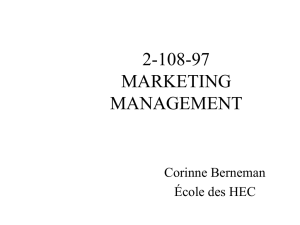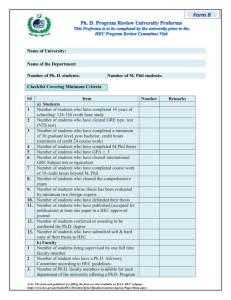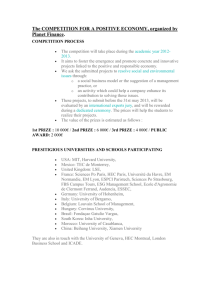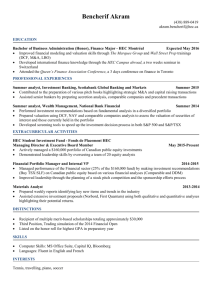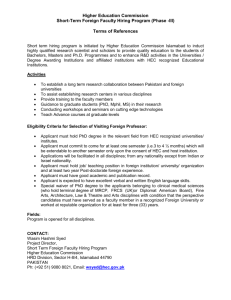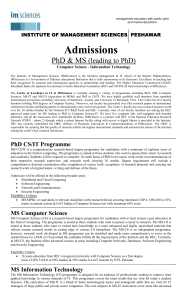Envisioning Inter-Islamic Research & Education Network (IIREN)
advertisement
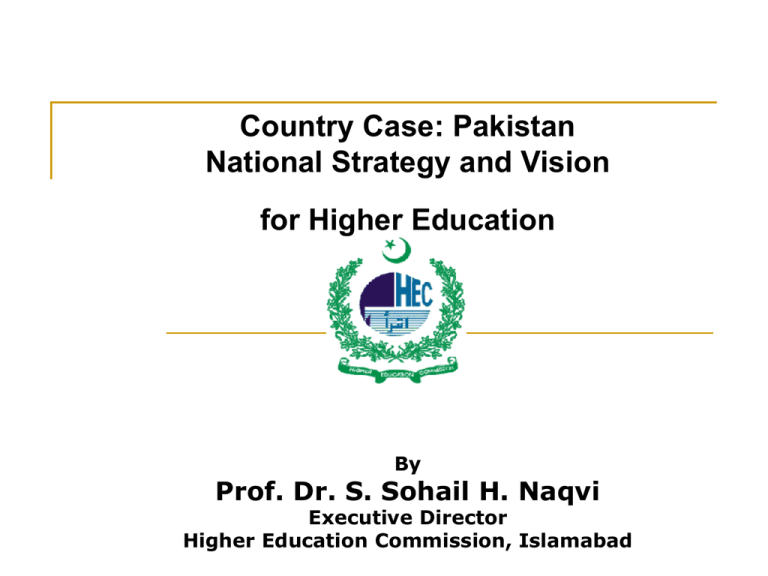
Country Case: Pakistan National Strategy and Vision for Higher Education By Prof. Dr. S. Sohail H. Naqvi Executive Director Higher Education Commission, Islamabad Outline of Presentation Background Higher Education Commission Formation Function of the HEC National Strategy & Vision Impact of HEC The next 5 years Higher Education Commission Background: Peril and Promise: Higher Education in Developing Countries, World Bank, 2000 Task Force on Higher Education in Pakistan, Report (2001) Steering Committee on Higher Education, Report (2002) Higher Education Commission Constituted on September 11, 2002 under Ordinance No. LIII, 2002 Autonomous: Prime Minister of Pakistan: Controlling Authority Chairman HEC: Status of Federal Minister Executive Director, HEC Has status of Federal Secretary Is the Principal Accounting Officer of the Commission Functions of the HEC Higher Education Development & Promotion Policy Formulate policies, guiding principles and priorities for higher education Institutions Financial Responsibilities Submit to the Federal Government the recurring and development budgets for public sector Institutions Allocate funds to public sector Institution out of bulk financial provision received from the government and other resources on performance and need basis Facilitate the introduction of educational programmes that meet the needs of the employment market Functions: Quality Assurance Prescribe conditions for opening and operating HEIs in the private sector Cause evaluation of the performance of Institutions; Carry out accreditation of Institutions including their departments, faculties and disciplines by giving them appropriate ratings Determine the equivalence and recognition of degrees, diplomas and certificates ….; HEC Mission To Facilitate Institutions of Higher Learning to serve as an Engine of Socio-Economic Development of Pakistan Key Areas of Improvement Access Quality Low enrollment in higher education Poor standard of faculty and lack of training / capacity building Low quality of teaching & research and lack of relevance to national needs Poor governance of universities Relevance Minimal relevance of higher education to national needs Core HEC Plan of Action Faculty Development Improving Access & Learning Excellence in Research Relevance to National Priorities Support Infrastructure Development: Physical, Technology Good Governance & Management Quality Assurance: Standards, Assessment, Accreditation Training the Brightest! Massive Foreign scholarship programs Focus on European Countries & China World’s largest Fulbright Scholarship program for the US Indigenous PhD programs Strict criteria for PhD Studies Complete Scholarship package Stipend, research support, tuition etc. Huge Local Scholarship Programs for Undergraduate level studies Attracting the Brightest Faculty! Changing the Environment Transforming UGC New University buildings, laboratories, facilities Access to information Access to sophisticated instrumentation Change in Salary Structures under “Tenure Track” system salaries of Professors raised dramatically Research Productivity Allowance (based on Cumulative Impact Factors during the preceding year) Attracting the Brightest! Research Funding Competitive – Peer Reviewed Grants to Attend Conferences Grants to host conferences 75% Reduction of Income Tax for all academics Reversing the Brain Drain Guaranteed Jobs to fresh PhD.s with higher salary structures under tenure track system Short Term Foreign Faculty Hiring Long Term Foreign Faculty Hiring A Focus on Quality Assurance Quality Assurance Structure Defining QA Procedures Establishing Standards Capacity Building Degree Verification Statistics Compilation & Ranking Liaison with Professional Accreditation Bodies Provinces International QA Agencies Quality Assurance Criteria 4 Year Undergraduate Program Eligibility Criteria for Faculty Appointment Tenure Track System Criteria for Recognition of Journals College Affiliation Criteria Quality Criteria for PhD Program Course Work at MPhil./PhD level International Refereeing of Dissertation International Publication HEC’s Major IT Initiatives INFRASTRUCTURE IT Reforms in Universities Pakistan Education & Research Network (PERN) PAKSAT-1 Virtual University SERVICES PROVIDED HEC Website Digital Library E-books Pakistan Research Repository MIT Open Courseware http://mitocw.pern.e du.pk Higher Education Web Portal National Digital Library 2002 2003 2004 2005 2006 No. of Institutions given Access - - 110 170 250 Training of NDL - - 5100 7500 10000 No. of Journals - - 14500 20000 22000+ - - 450000 + 665000 + 1200000 + 788 890 1048 1257 1500+ (Online) Articles Downloaded Research Output Curriculum Division Before 2004, Bachelor’s programme was of 2-year duration. 2004 Initiation of 4-year BS programme was taken up in 2004 and HEC designed a uniform curricula for about 60 disciplines by the year 2006. 2006 Template for Agriculture was designed and implemented in various Agric. Disciplines April 2007 Uniform Template for Engineering, Basic and Social Sciences was designed. Development of uniform curricula, in line with the templates developed, for the following disciplines are in progress. 7 disciplines of Basic Sciences 2 disciplines of Humanities 14 disciplines of Engineering Development Funding UGC in 2002 HEC in 2007 Total Development Funding Rs. 4.3B Rs. 14.3B Total Development Projects 147 354 Total Funds Released in Past 5 Years Rs. 1.881B Rs. 33.309B Total Funds Utilized in 5 Years Rs. 1.88 Rs. 26.68B 45 76 Number of Institutions Funded Development Funding Allocation of Budget in Approved Projects Others 1% HRD 59% Infrastructure 21% Research Enhancement 15% Access to Information 4% Recurring Funding UGC in 2002 HEC in 2007 Rs. 3.39B Rs. 14.48B 132,226 256,994 69 99 Rs. 4M Rs. 590M Promotion of Research Budget Rs. 46M Rs. 650M Number of MPhil/PhD Students 6,744 12,856 Percentage Self Generated Funds 48% 55% Library Budget (Incl. Dig. Lib) - Rs. 230M Recurring Funding per Student Rs. 25,629 Rs. 56,345 Funding per COE/ASC Rs. 5.641M Rs. 20.362M Funding per Chair Rs. 0.936M Rs. 3.136M Total Budget Number of Funded Students Number of Funded Institutions Inter Univ. Acad. Activities Budget IMPACT of HEC Pakistan Research Output 2001-2006 1800 1636 1600 1400 1257 1200 1048 1000 800 600 1532 890 788 636 460 576 1039 781 639 400 200 0 2001 2002 2003 2004 Pakistan Total University Output 2005 2006 Human Resource Development Description UGC in 2002 HEC in 2007 2 4 342 2861 0 15 0 1428 (1131) 1 1 45 259 Total Number of Projects 0 3 Total Number of Faculties hired 0 258 (175 st.) Indigenous Scholarship Projects Total Number of Projects Scholarships Availed Overseas Scholarship Projects Total Number of Projects Scholarships Availed Post Doctoral Fellowships Total Number of Projects Fellowships Availed Foreign Faculty Hiring Program Quality Assurance UGC in 2002 HEC in 2007 Not Available Available Quality Enhancement Cells 0 30 Accreditation Councils 7 11 Quality Assurance Agency None Established Approved Journal Criteria None Notified Approved Journals 0 77 Tenure Track Faculty 0 110 MPhil/PhD Award Criteria Varied Standardized Eligibility Criteria for appointment of faculty members Varied Standardized Affiliation Criteria Varied Standardized N/A Standardized Ranking of Universities Tenure Track Statutes HEC IT Evolution UGC in 2002 HEC in 2007 250 750 Basic IT Aware employees 8 550 IT HR 2 43 Servers 0 15 7+0 500+72 Printers 5 150 Network 0 750 nodes No Air link, Fiber 56kbps 8 Mbps Web site (Hits) 100 200k+/month Email Server No Yes Digital Library No Yes Video Conferencing No Yes Total HR Computers + Laptop Links Internet Learning Innovation No. Of Faculty Trained UGC in 2002 Short Term Professional Development Courses Long Term Professional Development Courses HEC in 2007 530 0 4249 3399 Open/Customized Workshops/Seminars Lectures/Seminars by Foreign Experts 0 0 295 190 Training through HEC Capacity Building Programs ICDL Training imparted 0 0 428 246 ICDL Resource Centers 0 05 __________________________________________________________________ GRAND TOTAL 530 8807 The Next 5 Years Projecting HE enrollment and population age group 2007 2011 2016 21.4 25.4 30.2 univ enrollment in 000 (Incl. Distance Education) 574 955 1840 colleges enrollment 000 310 377 480 univ+colg enrol 000 884 1332 2320 % univ enrol/pop 2.7 3.8 6.1 % colg enrol/pop 1.4 1.5 1.6 % HE (univ+colg) enrol/pop 4.1 5.2 7.7 Age 17-23 pop Are there Students ? Student pass HSC exam and univ intake (000), 2005-2015 800 HSC pass 700 univ intake 600 500 400 300 200 100 0 2005 2006 2007 2008 2009 2010 2011 2012 2013 2014 2015 Source: WB HE Assessment Report (2006) Additional Faculty Required (Public Sector) Type of Institution 2006/7 2009/10 2012/13 2015/16 General 5011 (852) 6,206 8,423 12,766 Sciences 3340 (1516) 4,050 4,903 7,431 Agriculture 1295 (211) 1,828 2,596 3,928 Engineering 1789 (211) 2,588 3,684 5,644 Medical/Life Sci 682 (34) 917 1,270 1,953 Total Faculty needs 12,117 15,589 20,875 31,722 Additional Faculty 1,176 2,716 4,131 annual increase 1.18 1.08 1.15 1.15 Financial Realities Education lies at the heart of development 2% of GDP 4% of GDP Higher Education at least 20% of Education expenditure The Government can not do it all Universities must enhance own income Private Sector Role is Crucial Distance Education HEC: The Next 5 Years 2007-2012 Institutional Ownership Quality Assurance Governance Recruitment of Faculty Mega Development Projects Public – Private Partnership Conclusion Higher Education in Pakistan has a new lease on life ! Vital to sustainable poverty reduction Key to building Pakistan’s Human Capital HEC Focus on Good Governance and Management Efficient Implementation: Capacity Building Relevance to National Priorities Higher Education Commission Fuelling National Growth

